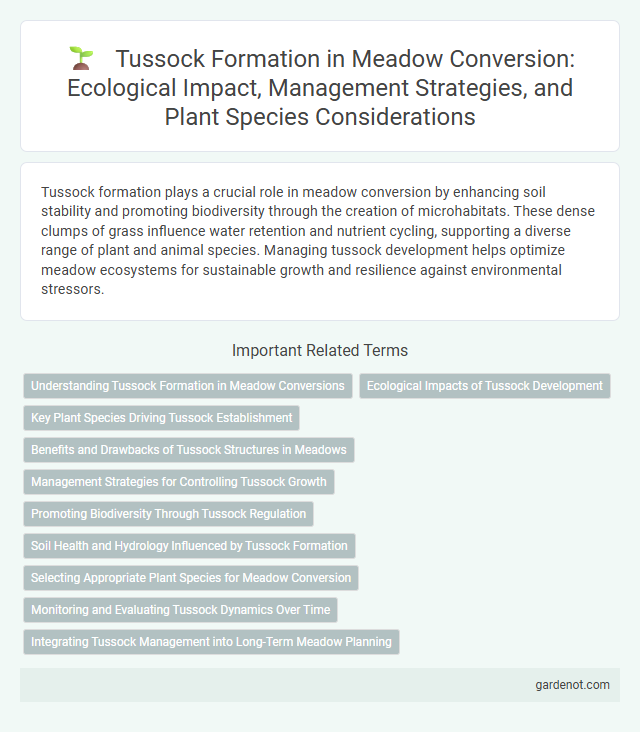Tussock formation plays a crucial role in meadow conversion by enhancing soil stability and promoting biodiversity through the creation of microhabitats. These dense clumps of grass influence water retention and nutrient cycling, supporting a diverse range of plant and animal species. Managing tussock development helps optimize meadow ecosystems for sustainable growth and resilience against environmental stressors.
Understanding Tussock Formation in Meadow Conversions
Tussock formation in meadow conversions occurs as perennial grasses and sedges grow in clumps, creating hummock-like structures that influence soil aeration and moisture retention. These tussocks enhance biodiversity by providing microhabitats for insects, small mammals, and ground-nesting birds. Understanding tussock dynamics is essential for managing meadow ecosystems and promoting sustainable habitat restoration.
Ecological Impacts of Tussock Development
Tussock formation significantly enhances biodiversity by creating microhabitats that support various plant and animal species within meadow ecosystems. These clumps of dense vegetation improve soil stability and water retention, reducing erosion and promoting nutrient cycling. The heterogeneity introduced by tussocks fosters ecological resilience, enabling meadows to better adapt to environmental stresses such as drought and grazing pressure.
Key Plant Species Driving Tussock Establishment
Key plant species driving tussock formation in meadow conversion include Calamagrostis stricta, Carex cespitosa, and Deschampsia cespitosa, which exhibit robust clonal growth and dense root mats essential for tussock stability. These species' adaptability to waterlogged soil and their ability to trap organic matter accelerate sediment accumulation, fostering tussock elevation. The dominance of these graminoids directly influences microtopography, hydrology, and biodiversity patterns in newly established meadow ecosystems.
Benefits and Drawbacks of Tussock Structures in Meadows
Tussock structures in meadows enhance biodiversity by providing microhabitats for various flora and fauna, improving soil aeration and water retention through their dense root systems. However, these formations can also impede uniform vegetation growth, potentially reducing forage availability for grazing animals and complicating meadow management. Balancing tussock benefits with their spatial dominance is crucial for optimizing ecological function and pasture productivity.
Management Strategies for Controlling Tussock Growth
Effective management strategies for controlling tussock growth in meadow conversion include regular mowing to prevent seed dispersal and reduce biomass accumulation, which limits tussock dominance. Controlled grazing by livestock can selectively suppress tussocks while promoting desirable meadow species, enhancing biodiversity. Integrated approaches combining mechanical removal with targeted herbicide application offer precision control, minimizing environmental impact and supporting meadow ecosystem restoration.
Promoting Biodiversity Through Tussock Regulation
Tussock formation creates microhabitats that support diverse plant and animal species, enhancing overall ecosystem biodiversity in meadow landscapes. Regulating tussock density and distribution mitigates soil erosion and promotes nutrient cycling, fostering a balanced and resilient habitat. Effective tussock management encourages the coexistence of rare flora and fauna, contributing to sustainable meadow conversion outcomes.
Soil Health and Hydrology Influenced by Tussock Formation
Tussock formation significantly enhances soil health by increasing organic matter accumulation and promoting microbial activity within meadow ecosystems. These elevated structures improve hydrology by facilitating water infiltration and reducing surface runoff, which supports moisture retention and nutrient cycling. Consequently, the presence of tussocks creates microhabitats that regulate soil temperature and moisture dynamics, essential for sustaining diverse plant communities and overall meadow resilience.
Selecting Appropriate Plant Species for Meadow Conversion
Selecting appropriate plant species is crucial for effective tussock formation in meadow conversion, with native grasses like Festuca ovina and Deschampsia cespitosa demonstrating strong clumping growth patterns. These species promote soil stability and enhance biodiversity by providing habitat structures conducive to wildlife. Emphasizing local ecotypes ensures better adaptation to soil conditions and climate, optimizing tussock density and meadow resilience.
Monitoring and Evaluating Tussock Dynamics Over Time
Monitoring and evaluating tussock dynamics over time involves systematic measurement of tussock size, density, and distribution using remote sensing technology and field surveys to track changes accurately. Data analysis integrates temporal satellite imagery with ground-truthing to assess growth rates and degradation patterns, enabling adaptive management strategies for meadow conversion projects. Continuous monitoring supports early detection of environmental stressors affecting tussocks, ensuring sustainable ecosystem restoration and biodiversity conservation.
Integrating Tussock Management into Long-Term Meadow Planning
Integrating tussock management into long-term meadow planning enhances biodiversity by supporting native grassland species and improving habitat complexity. Effective tussock control methods, such as targeted grazing and periodic mowing, prevent excessive tussock dominance that can suppress desirable forage plants. Long-term strategies incorporating ecological monitoring and adaptive management ensure sustainable meadow productivity and resilience.
Tussock formation Infographic

 gardenot.com
gardenot.com